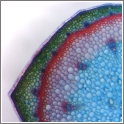Passive oscillation damping

In the absence of a damping atmosphere it is difficult to damp oscillations of booms in spacecraft. It can take up to several hours following a spacecraft turning manoeuvre until the vibration has damped out. The performance of pointing and tracking systems can thus be severely affected by the presence of long mechanical booms. Practical countermeasures include active damping (using piezoelectric materials) or shaping the control command via input or command shaping techniques.
Plant stems, on the other hand, have built in oscillation damping (or keeping, depending on the ecology) mechanisms resulting from a clever arrangement of the skeletal tissue (sclerenchyma). This is due to the fact that they are as well exposed to oscillation, e.g. caused by squally winds, so that well adapted structures evolved during hundreds of millions of years.
Such an arrangement, or its working principle, could be mimicked and embedded in the very structure of satellites booms such as magnetometers or of solar panels, to give the overall structure a passive damping capability without introducing a mass penalty or using complex control and actuation devices. To make this principles evident oscillation of different plants is tested and their cross section analyzed.